Home | Front Page | Index | Blog | New | Contact | Site Map
Winter
Nazi Terror
Churches
Museums
Prussian palaces
Alte Stadt
Modern Architecture
Shopping
Quirks
Bei Uns (At Home)
Guests
Maps
Pics
Foto Show

Museums
Alte Nationalgalerie
Altes Museum
Pergamon
Gemäldegalerie
Dahlem Meso-America
Deutsche Dom
Topologie des Terrors
Jewish
Stadt
Communications
Technik
Travel 2005
Berlin
Paris
Moscow
Russia
Athens
Travel 2004
Mexico 2004
Belize
Guatemala
Honduras
Costa Rica
Panama
Colombia
Ecuador
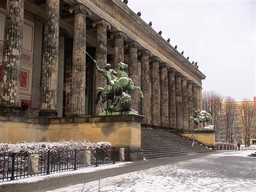
Altes Museum |
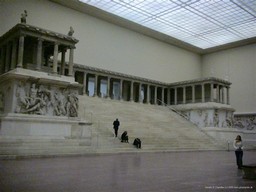
Pergamon Museum |

Alte Nationalgalerie |
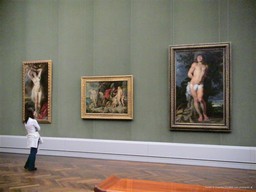
Gemäldegalerie |
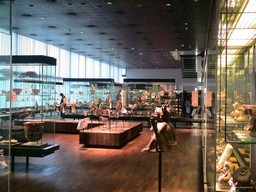
Dahlem Museum |
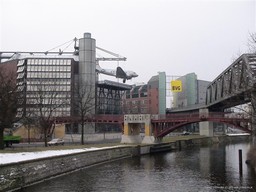
Technik Museum |
Berlin is richly endowed with museums, as befits a great European capital city. These museums, however, are going through an enormous period of upheaval that began with the reunification of the country and the city. Collections that once were "split" between east and west are now being logically reorganized and merged. Most of the older museums in Berlin were located in the old city center which became part of the Soviet sector after the war and was then incorporated into the German Democratic (sic) Republic as its capital. After reunification, the DDR museums were in need of considerable investment and refurbishment both to compensate for the lack of money available to them in the previous forty-five years and to bring them up to date in terms of the type and quality of display methods.
Modern and Classical Art - Three Islands
Four of the greatest museums were on Museum Island, a micro-Manhattan island that sits between the Spree and the Spree Canal; eight centuries ago it is where the city was founded. One by one, the museums on Museum Island have been closed for refurbishment and collections have been merged and then redistributed among the city's various museums. It is a process that hasn't finished yet. We got to see the classical collections in the Pergamon and Altes Museum. The Bode Museum was closed for refurbishment; when it re-opens it will house the Egyptian collection moved from the former Egyptian museum opposite Charlottenburg Castle. We saw part of that at a special exhibit at the Gemäldegalerie where, after thirty-one years, we revisited the plaster bust of Nefreteti.
Also on Museum Island is the Alte Nationalgalerie which houses mostly German 18-19th century paintings and sculpture. The big home for 15-18th century art is the Gemäldegalerie, which is the anchor of another Island, the Culture Island to the west of Potsdamer Platz in former West Germany. Located on this "island" is the Philharmonic Hall, the new National Library, and two other museums. One, the Neue Nationalgaleri, home to modern/contemporary art, we deliberately gave a miss. Housed in a glass-sided starkly modern building, it dominates its corner. Another, the Folk Arts museum, seemed to be always closed when we went.
Three other art museums that we visited, but which we don't picture here are the Berguen Museum specializing in late 19th century art (particularly Picasso), the Brohan which has a fantastic collection of Art Nouveau works (mostly made in Germany), and the City's Stucco museum which had stucco copies of many statutes.
A third "Museum Island" is the Dahlem museum complex, named after the city district in which it is located. Referred to as an ethnological museum, it treats art and society in an integreated way. The primary and far largest part is located in what to you and me is a single building but is officially four buildings with four collections: East Asian (primarily Buddhist) art, Meso-American, African, and Oceanian. Much of the collection comes from the work of German researchers and colonizers; thus many of the African works come from in and around Cameroon, a former German colony. Similarly the Oceania is heavily based on works collected by German explorers of New Guinea.
History and Technology
We saw the German (Political) History Museum (housed in a monumental former church) which covers the development of Germany democracy from the founding of Brunswick, Prussia, through the years of Bismarck, the first World War, Hitler and aftermath, the separation into East and West Germany, and ultimate re-unification. Berlin's own history is extensively covered in the Stadt Museum. We saw a focused display of the history of a small town in the Köpenick Museum. What we think is a similar exhibit is at Spandau Castle but we didn't get to go into the museum.
On the grounds of Schloss Charlottenburg is the Ethnological or Pre-history Museum. We found their extensive collection of bronze and stone age artifacts to be very interesting. It doesn't compare to the great collection we saw in Paris but this one is manageable; it can be seen in half a day.
Four museums and several memorial sites are related to Nazi Terror and the attempt to murder all Jews. Covered on another web page, they are the Sachsenhausen Concentration Camp, Wannsee Conference "Final Solution", Topographie des Terrors, Widerstand Museum, Jewish Museum, and several related memorials. Besides these we visited the Allies Museum, which treats the post-war history of Berlin from the creation of the four occupation zones until the true re-unification and end of "occupation." It is located just south of Dahlem, and was once part of a US military base. Part of the museum was once the base theatre.
Specialized museums abound, big and small. The biggest is the Technik Museum. Way behind, but still big is the Post Office Communications Museum which displayed mostly old and new telephone equipment but also TV and Radio equipment, and some stamps. It is housed in a lovely late 19th century building that is as interesting as the collection it houses.
Altes Museum
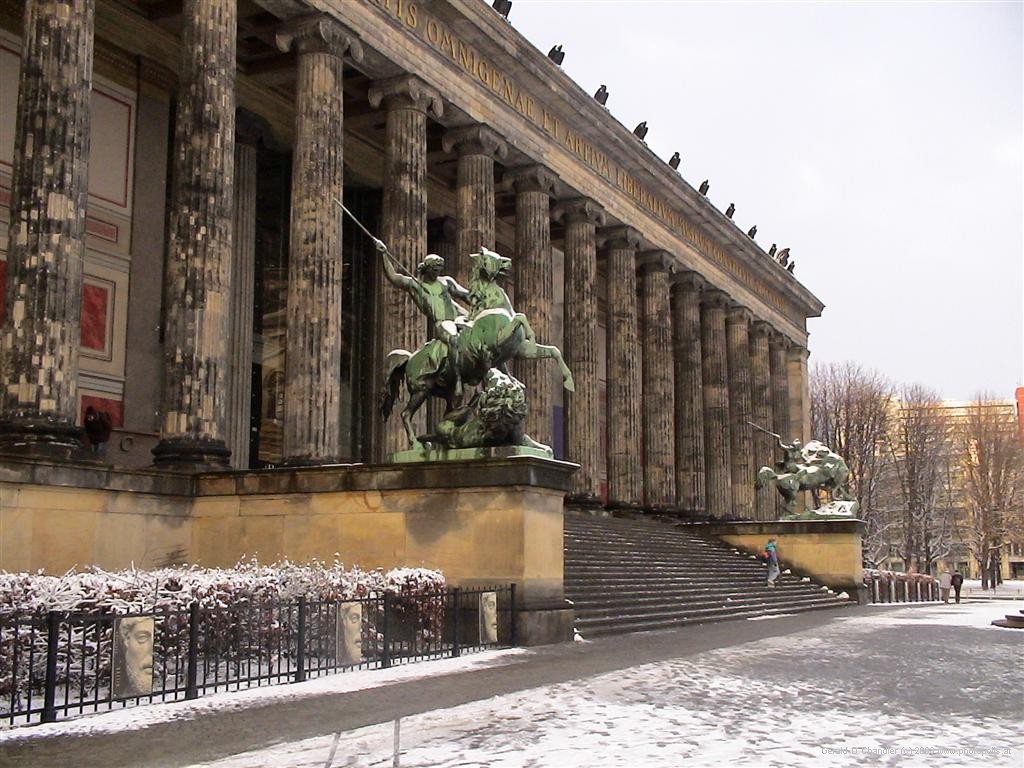
Altes Museum |
One of the four museums on Museum Island, the Altes Museum houses a very comprehensive collection of Greek art. We did not know when we visited that before the end of the year we would be in Athens ourselves but that, as they say, is another story. We were both very impressed with the collection and especially the explanations that accompanied the collection. Would that we had retained some of it!
The interior of the building has been pretty well refurbished and makes a modern setting for a museum. The exterior, as shown in the photo, still needs quite a lot of work. Perhaps when work has been completed on the Bode Museum (Egyptian and Byzantine Art), the exterior of the Altes Museum will be next.
Pergamon Museum
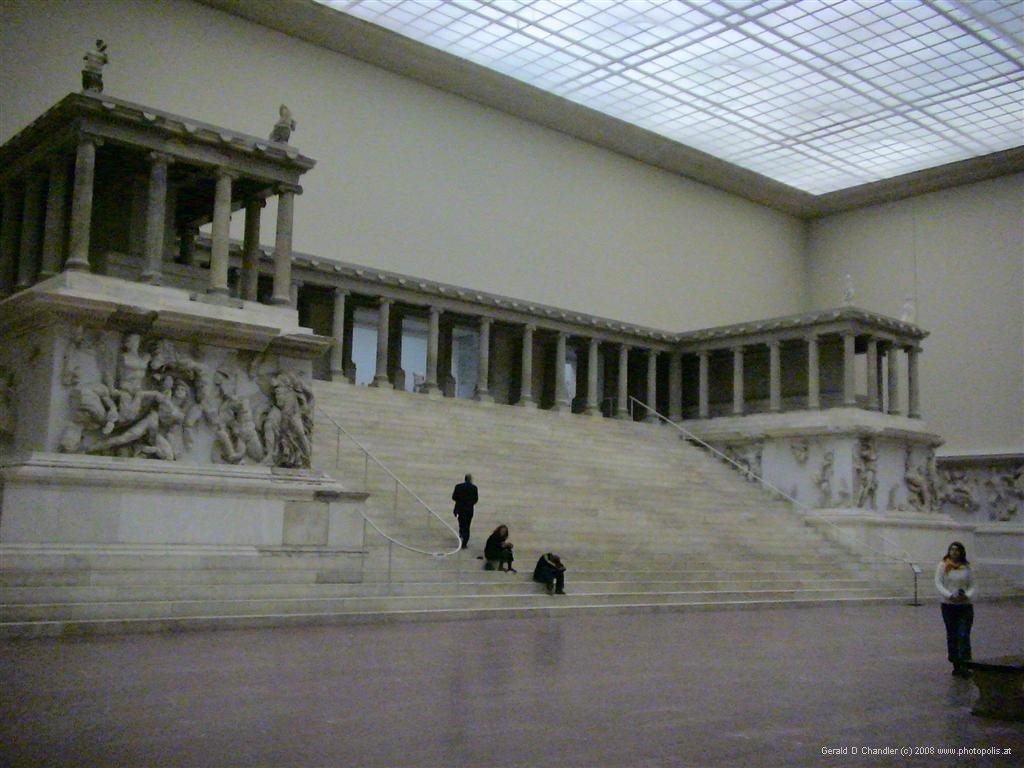
Temple of Zeus, Pergamon Museum |
The only things we remember about the Pergamon from our first visit in 1974 are the imposing entry steps and the frieze and altar from the Zeus temple at, of course, Pergamon. Since that visit we have been fortunate to have visited the site of the Zeus temple, the former ancient city of Pergamon and the nearby Turkish town of Bergama. Luckily, we had allocated a whole day for the museum, because of course it contains much more than just the Zeus temple. Most impressive is the Assyrian gate, a glazed tile gate and processional way reproduced in the museum itself. Equally impressive and on the same kind of scale is the Roman market gate from Miletus. You enter a cavernous room and one entire wall is taken up by this beautiful gate with its enormous fluted columns. Sadly for us, it was covered with netting to protect visitors from falling debris. The gate is in such sad shape after years of (benign) neglect from the DDR state that much work is needed to make it safe without damaging it. We hope our entrance fee helps.
Alte Nationalgalerie
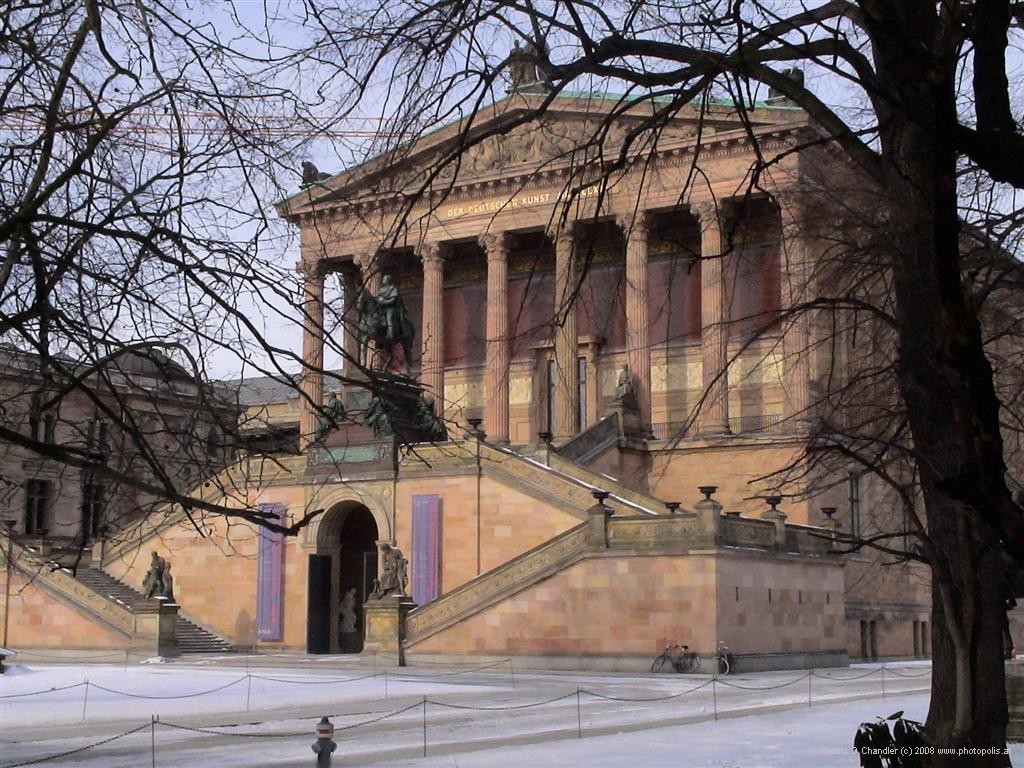
Alte Nationalgalerie |
This lovely greek revival building probably houses a wonderful collection. Sadly, however, we got to see only a very small part of it as two thirds was closed so that a new exhibit could be installed while we were there. Perhaps that is another downside of being here in winter. Fewer museum visitors and so an opportune time to revamp the place for the summer crowds.
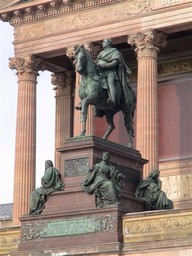
Alte Nationalgalerie |
Nonetheless, what we did see pleased us, not least the building itself. As its name suggests, it is an art gallery. Its collection celebrates national artists, however, unlike the Gemäldegalerie which concentrates on European masters. We saw only one floor of the collection, which contains a lovely sculpture room and then a series of rooms, each devoted to a different German artist. Most of the artists were new to us, but on the whole it was a worthwhile visit. Jan's favorite was the bronze model of a statue of Frederick the Great that was built for Berlin. It is now located on Unter den Linden just outside of Humboldt University. The trouble with monumental statues is that you can't always see the detail you want to. This model, which stood about six feet high was just perfect as most of it was at eye-level.
Gemäldegalerie
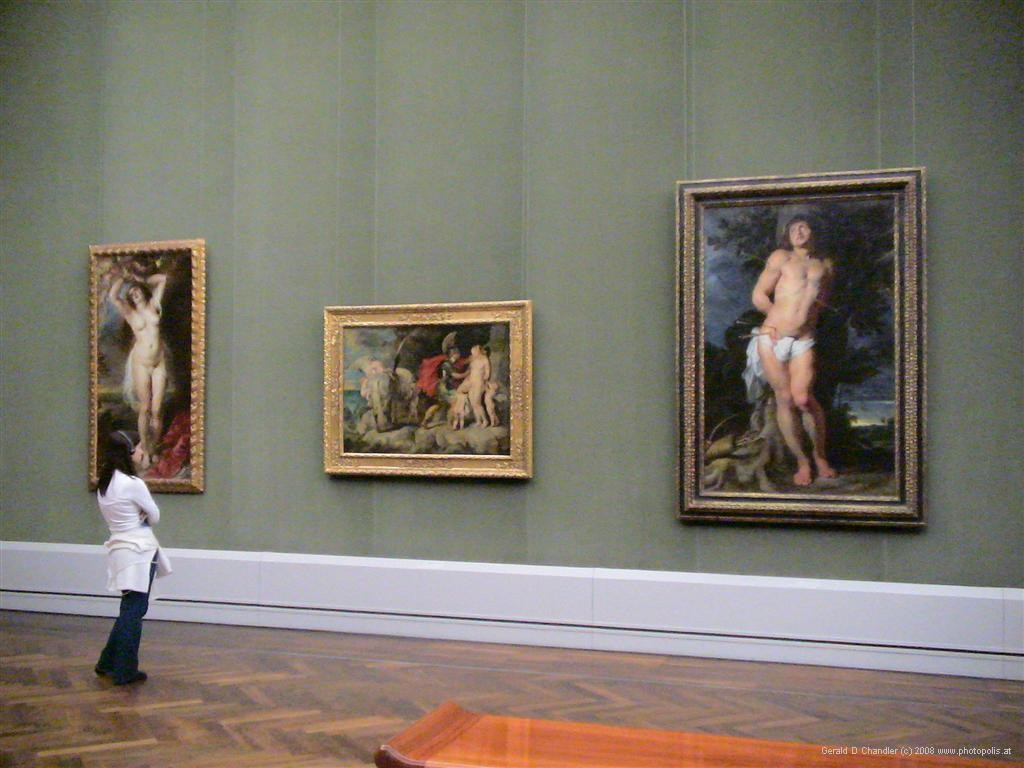
Gemäldegalerie |
The Gemäldegalerie was easily Jan's favorite museum in Berlin. She has a predilection for what one might call "pre-Modern" art. Having fallen in love with the impressionists in her youth, she now much prefers the earlier masters such as Ingres and David, Delacroix and Corot, not to mention Rembrandt and Hals, Vermeer and so on. And there are always new masters to get acquainted with. In Berlin we got to know the Cranachs, Elder and Younger.
The Gemäldegalerie collection is not huge but they do have some very lovely pieces. They also have a wonderful tradition, that of free Thursday evenings which they share with other museums in the city. We took advantage of it three times and spent from six until ten happily wandering the rooms along with a handful of other retirees and about as many students. Fortunately for us, not too many people were interested in going out into the cold winter nights to visit an art museum. As an added bonus, there was always a group of art students available to offer explanations of famous paintings which gave Jan some useful practice in German comprehension as well as an art education. A terrific deal.
Dahlem Museums
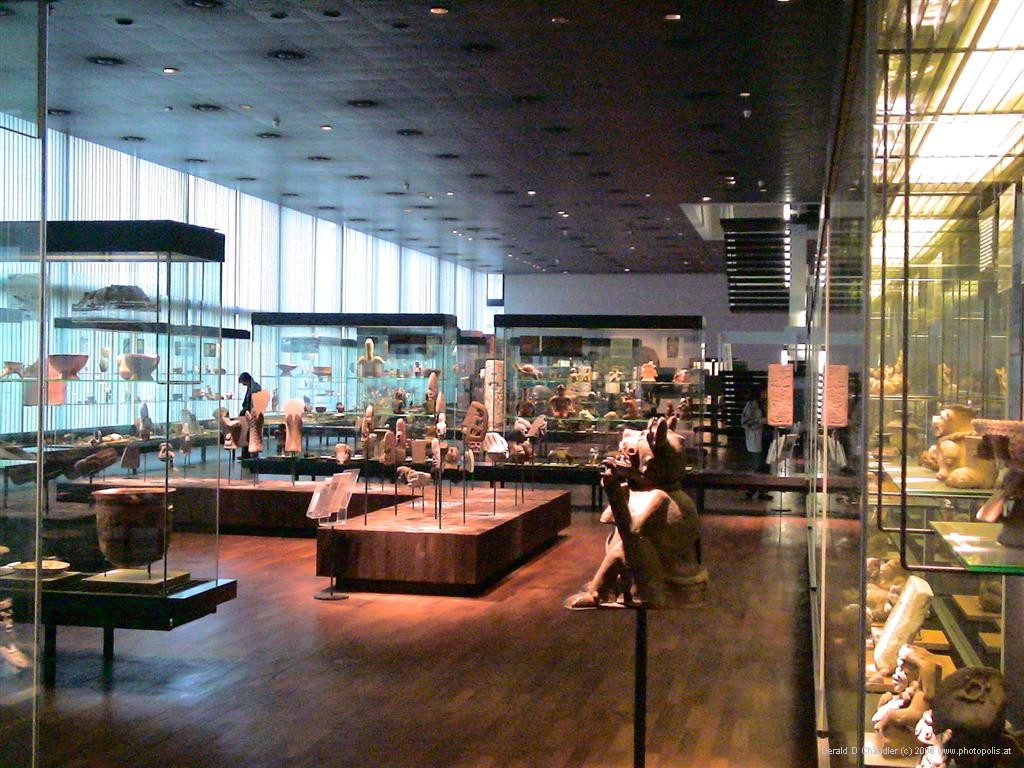
Meso-American Room, Dahlem Museum |
The Dahlem museum complex houses four museums in one building. Located in former West Berlin, the collections were built up to compensate for the loss of Berlin's original museums on museum island and part of East Berlin. Since reunification, of course, the collection has received additional pieces from sister museums as collections get shuffled about. The most impressive part of the Dahlem museum is undoubtedly its collection of ethnological pieces from the south seas. There is also a nice southeast Asian collection, a very respectable collection from South America, and even an African collection. We visited twice to have time to really explore the place.
German Political History

Deutsche Dom
|
The German Political History Museum is located, strangely, in a former Cathedral! There are two former cathedrals that sit side by side dubbed the German Cathedral and the French Cathedral. One served German protestants, the other French Huguenot protestants. Today both are museums. While we were in Berlin the refurbishment of the French cathedral (der französische Dom) was still underway. The German cathedral (der deutsche Dom) however, now houses a terrific collection that traces the history of Germany from its unification in 1870 until the present day. We love this kind of museum with lots of photos and recordings, both audio and video, to tell the story of the rise and fall of German democracy and finally its rebirth. A very dramatic tale.
Stadt Museum - The History of Berlin
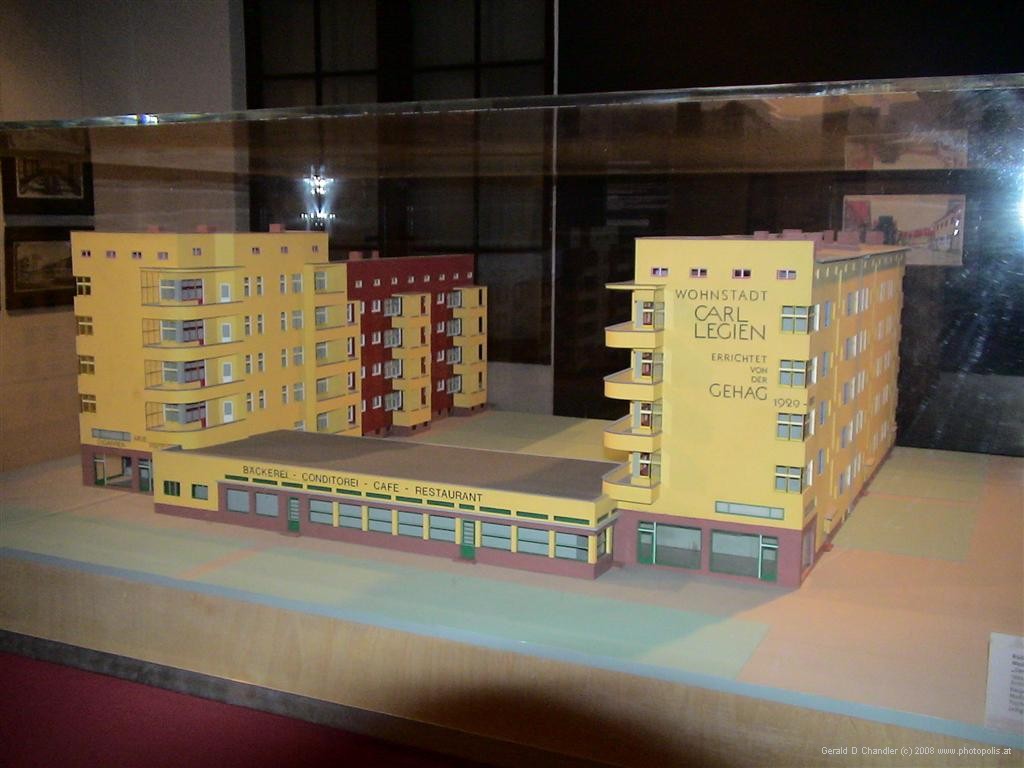
Stadt Museum |
Berlin was offically founded about 1230 and it has been growing ever since. (The years from the end of WWII to the end of the cold war were exceptional in that it shrank.) This museum covers it all, right through and beyond the swinging 20s and the cabaret years. It is fascinating to those who care about history. The museum building was specially built but incorporates many teutonic and church elements, each planned for the displays they would contain.
Post Communications Museum
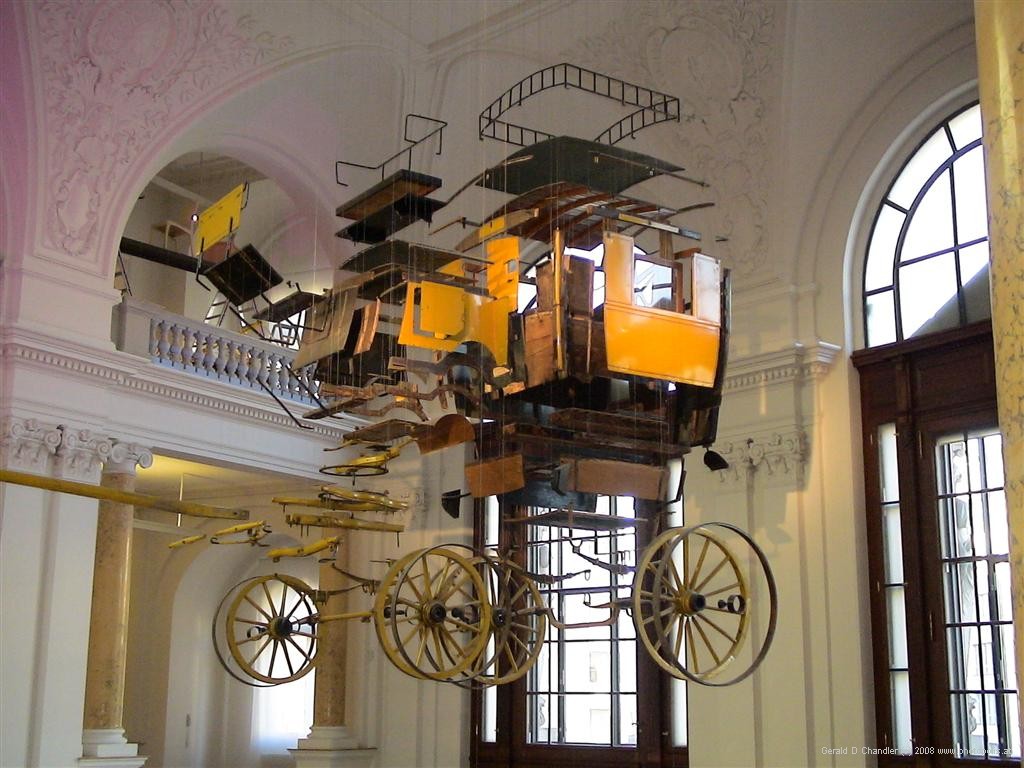
Disassembled Post Coach, Communications Museum |
The Post Museum is located almost at the heart of the city, in a very pleasant late 19th century building. One room is devoted to "firsts". It comes as no surprise that Germans invented many things that the British think they invented and that, unlike the British, the Americans are sure they invented. The explanation, of course, is that early inventions don't always quite work and useful things are really the result of many successive improvements.
Deutsches Technikmuseum
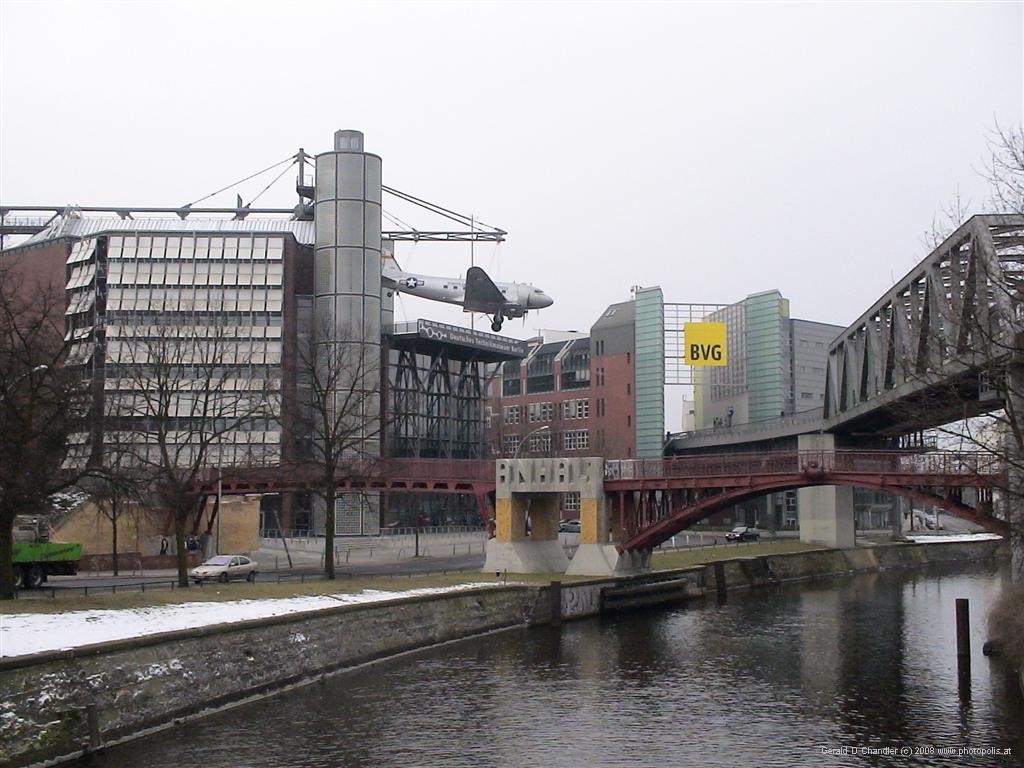
Technik(al) Museum: Air, Land, Sea, & More |
We waited until almost the last day of our stay to visit the German industrial arts museum that was literally across the street from our apartment. Jan really liked the skyscape the museum afforded. The museum grounds contained a couple of windmills, a water tower, and beyond it you could see more of Berlin. The pleasing skyscape, however, was visible only at night when light on each of the structures along with their strange shapes made it look like a scene from some exotic Arabian city with windmills and water tower standing in for mosques and minarets.
We delayed our vist to the museum hoping to get some warmer weather for the outdoor exhibits. It was the right decision in that the day we did go, although it rained some, the temperature was at least 10C (50F) which seemed so very warm to us after two months of at or below freezing. The museum turned out to be fascinating. The largest sections are all about planes and boats and trains, in the words of the song. Sadly the plane area was closed in this, the off-season, but there was more than enough to fill our day. The train section reminded us strongly of the York Railway Museum in northern England, except that York did not have on display one of the cattle cars used to deport Jews. Gerry really liked the scale models of various train stations.
The boat-section was less moving, but we don't think we have ever seen such a nice display of boat-building as we found here. The most amazing exhibit was of a cargo boat that had been dredged up from a river bed, restored and set up with a new mast and sails. It even had on board the roofing tiles that it had been carrying when it was sunk. Elsewhere was another shipwreck display, but this time of the cargo of another ship that sank in the South China Sea with an enormous cargo of porcelain on board. The discoverers of the wreck brought the cargo to the surface, cleaned it and auctioned it, no doubt at a great profit. A portion of the cargo and a film about the discovery and raising of the cargo are now in the museum. In our minds-eye we were able to make some interesting comparisons with the human-powered boats of the south-seas on display at Dahlem.